Classic car reviews
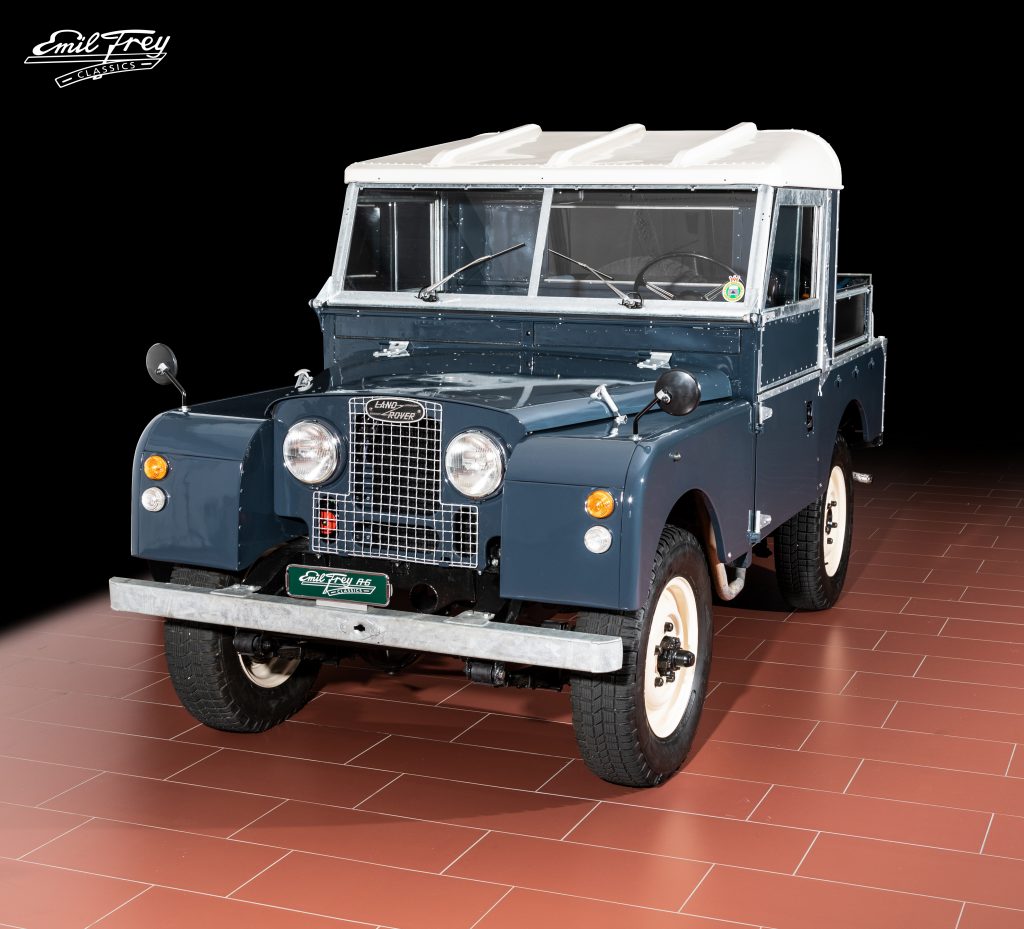
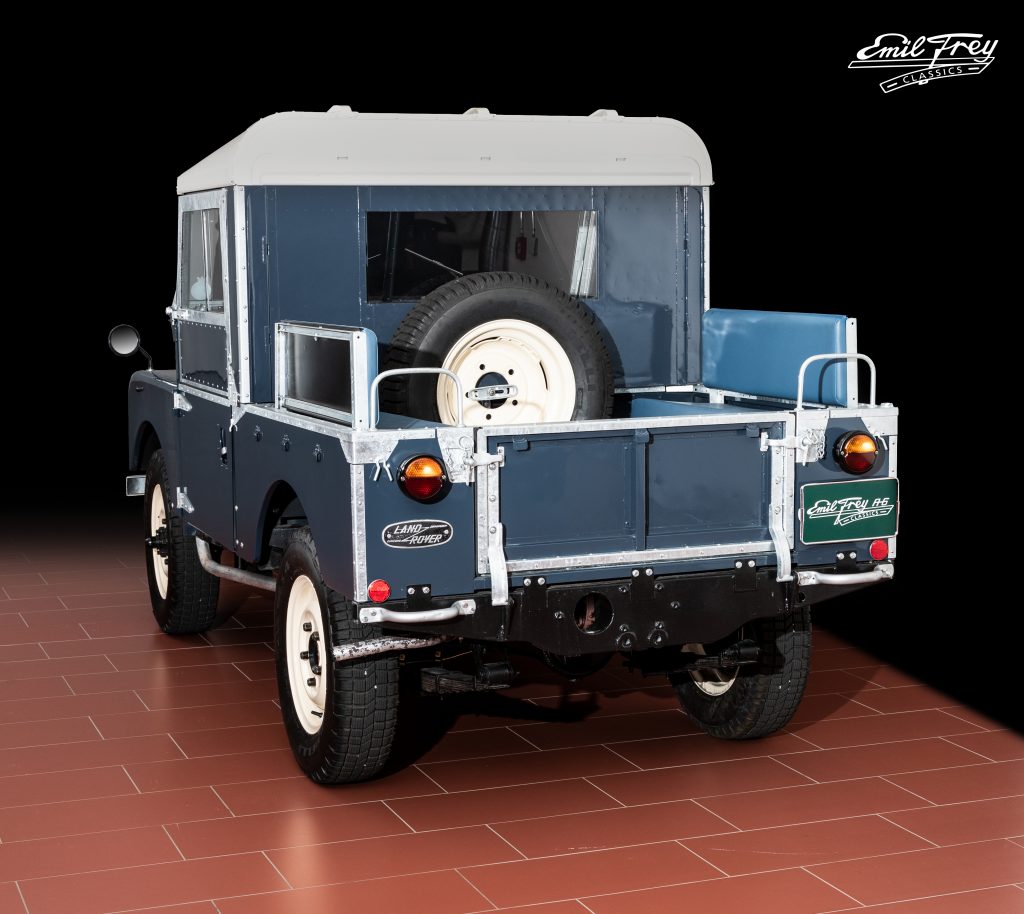
Land Rover 86 Series I - Form follows function
Actually, the story of the Land Rover reads almost like a fairy tale. It was created almost by accident and celebrates its 75th birthday in 2023. Until 2016, it was constantly modernized, but not fundamentally changed. And by then, over two million examples had been built, more than of any other Rover in the company’s history.
However, the Land Rover was not born entirely by chance. In fact, after the war, Rover had an almost new factory in Solihull, but no new models that could be sold and exported in larger numbers. A small car design called the M1 did not prove to be the right answer to post-war demands.
Maurice Wilks, the chief engineer, had a farm on the island of Anglesey, just off the northern coast of Wales. The 62-hectare site extended all the way to the sea. In order to remain mobile on the sometimes impassable land and to be able to work, which Maurice enjoyed doing in his spare time, he used a Willys Jeep that had been decommissioned by the military. His brother, Spencer Wilks, Managing Director of Rover, is said to have asked Maurice one day in the late 1940s what he would do if the Jeep gave up the ghost.
Maurce replied that there was no alternative and that he would probably be forced to buy another Jeep. Why not produce a similar vehicle at Rover, for which there would certainly be a market, was the obvious question at the end of this discussion. And so, in early 1947, the two decided to do just that.
The Jeep served as inspiration, but was not simply copied. By the summer of 1947, the first prototypes had already been constructed. Still in September 1947, the Rover Board of Directors gave the green signal for series production.
Purpose design
The off-road vehicle, which was named “Land Rover” at an early stage, was to take account of the prevailing material shortages and be easy to build. For this reason, the aluminum alloy “Birmabright” was chosen as the basic material for the body. Aluminum was easy to process and weighed less than sheet steel, it was corrosion-resistant, and it was also available in larger quantities because demand for aircraft construction had declined. The body was manufactured in three separate parts that could be assembled independently of each other.
Too much artistic design input was not necessary. The decision was made to use mainly flat surfaces. Utility took precedence over aesthetics.
A cost-effective solution was also sought for the chassis. It was decided to weld steel strips together to form box-shaped components and to arrange them in a ladder frame. The result was a torsionally rigid chassis. Robust rigid axles with semi-elliptic springs were chosen for the suspensions. Braking was hydraulic with drums, controlled by a Burrman-Douglas steering system. The mechanical handbrake acted on the rear cardan shaft.
The engine chosen was the existing four-cylinder from the Rover P3. From 1593 cc, the side-camshaft engine developed 50 hp at 4000 rpm.
The four-speed transmission was also taken from the P3, but with shorter gearing and an additional gearbox for off-road use. All four wheels were driven, and the front-wheel drive could be disengaged via a freewheel clutch. In addition, it was possible to use the engine’s power in the form of a stationary drive to power a saw, for example.
Presentation in Amsterdam
The Land Rover had already been undergoing intensive testing since the fall of 1947, and 48 pre-production vehicles were built. On April 30, 1948, the off-road vehicle was then presented at the Amsterdam Motor Show. However, the car show in Holland was a manageable affair. Just 45 passenger cars from America, Germany, England, France, Italy, Sweden and Czechoslovakia were presented, 18 of which came from Great Britain. In addition, there were a few trucks and one sports car.
John Rozendaal’s coverage in “Das Auto” magazine did not mention the Land Rover. Presumably, he was simply not interested in this rustic off-road vehicle, which probably did remind him somewhat of the Jeep and the war.
Apparently, however, there was considerable interest in the new product, because many export markets, especially those with poor roads, expressed a need for it. The Land Rover had hit the mark.
Series production began in July 1948, and by the end of the year a more luxurious “Station Wagon” model with seven seats was introduced. Just one year later, the first government order for the Land Rover was received, and by 1950, 24,000 units had already been produced. Exports brought five million British pounds into the tight coffers. There was no getting around the Land Rover.
Wheelbase as type designation
As early as 1950, permanent four-wheel drive was replaced by a system that allowed a choice between two- and four-wheel drive in the higher speed range, while permanent drive for both axles was always used in high-reduction operation. In 1952, displacement was increased to two liters, in parallel with the four-cylinder in the Rover P4.
Finally, in 1953, the wheelbase grew to 86 inches, and a long-wheelbase version with a 107-inch wheelbase was also introduced. From then on, the wheelbase in inches was part of the type designation, and the car was referred to as the Land Rover 86 or the Land Rover 107. In 1958, the wheelbase then grew further to 88 and 109 inches. Also a diesel engine was taken up as two-liter to the construction program.
The Tempo Land Rover
The off-road vehicle, which was named “Land Rover” at an early stage, was to take account of the prevailing material shortages and be easy to build. For this reason, the aluminum alloy “Birmabright” was chosen as the basic material for the body. Aluminum was easy to process and weighed less than sheet steel, it was corrosion-resistant, and it was also available in larger quantities because demand for aircraft construction had declined. The body was manufactured in three separate parts that could be assembled independently of each other.
Too much artistic design input was not necessary. The decision was made to use mainly flat surfaces. Utility took precedence over aesthetics.
A cost-effective solution was also sought for the chassis. It was decided to weld steel strips together to form box-shaped components and to arrange them in a ladder frame. The result was a torsionally rigid chassis. Robust rigid axles with semi-elliptic springs were chosen for the suspensions. Braking was hydraulic with drums, controlled by a Burrman-Douglas steering system. The mechanical handbrake acted on the rear cardan shaft.
The engine chosen was the existing four-cylinder from the Rover P3. From 1593 cc, the side-camshaft engine developed 50 hp at 4000 rpm.
The four-speed transmission was also taken from the P3, but with shorter gearing and an additional gearbox for off-road use. All four wheels were driven, and the front-wheel drive could be disengaged via a freewheel clutch. In addition, it was possible to use the engine’s power in the form of a stationary drive to power a saw, for example.
Like almost 70 years ago
A surprising number of the more than 200,000 Series I Land Rovers built up to 1958 have survived. Anyone who takes a seat in one experiences pure nostalgia. A driving experience almost doesn’t get much more analog than this.
There are three seats in the front of the first-series Land Rover 86, and another four on the bench seats in the back. The fabric roof can be removed or unbuttoned in about five minutes. Only the accommodation of the canvas roof causes a bit of a headache when fully occupied. The Land Rover doesn’t want to be a sports car, but the 52 hp is enough to keep up in country road traffic.
However, its real domain – rough terrain – is hardly expected of a lavishly restored Land Rover, like the photographed example from 1955. In fact, the off-roader in the very rare, but quite authentic Navy Blue livery was so extensively restored by an enthusiast that one could speak of a concours restoration. He even rebuilt the wiring harness true to the original. Many of the original panels of the Landy, once delivered by the Sares company in Lausanne to the first owner in Treyvaux in the canton of Fribourg, could be saved.
Accordingly, the gem, which has only covered just 500 kilometers since its rebuild, is handled with care today. But even driving on paved terrain is fun in the Land Rover. You can feel the technical response to every movement, have a good all-around view and listen to the satisfied utterances of the two-liter engine.
It feels as if time has stood still. And actually it did until 2016, when the last descendant of the original Landys was built. And it wasn’t until 2020 that a much more modern successor appeared, which many Ur-Land Rover owners may not like at all. But after all, there are still some early examples.
Guest author: Bruno von Rotz
Picture and video: Michael Klauser
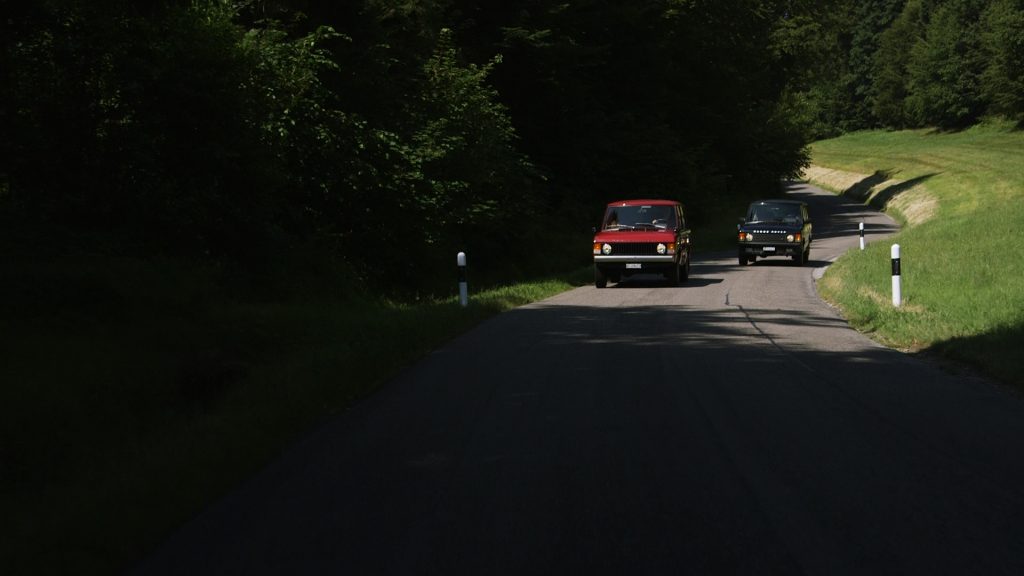
From SUV to luxury vehicle
The first-generation Range Rover was built over a period of 25 years, with customer demand driving changes in the design and equipment. After nearly four years of development, the Range Rover was introduced in June 1970. Like the Land Rover, the elegant aluminium body contained a ladder frame chassis and two solid axles. For the engine, the Rover engineers chose a light metal V8, once adopted by Buick, coupled with a four-speed gearbox. The result was 132 DIN hp, helping to power the 1770-kg vehicle. The three-door Range Rovers featured a fold-down rear seat and a two-piece tailgate, with the window upwards and the lid folded down.
Competition for the original Range Rover
The first major innovation came in 1980, when Monteverdi offered a four-door version in collaboration with the manufacturer. Further factory adjustments began in 1981. The automatic version came in 1982, and in 1985, fuel injection replaced the carburettor. Little by little, the once-rustic SUV turned into a luxury SUV. Leather, air conditioning, power windows and a central locking system were soon offered – and help to explain the eventual launch of the “Vogue” luxury variant. The capacity of the V8 engine grew to 3.9 litres, with the KAT engine introduced in 1987. In 1992, a variant of the engine, 20.5 cm bigger, offered even more space and 4.2 litres of displacement. The P38A successor appeared in 1994, though production of the “classic” (original) Range Rover continued until 1996. Approximately 330,000 models were manufactured in total.
An elegant workhorse
From the outside, the early-era Range Rover still looks modern and quite elegant. But when you step inside, the SUV is immediately clear: rubber floor mats, gross schlautiger lever, the cluster of simple instruments and little by way of comfort. When driving, you can feel and hear the mechanics. The four-speed gearbox wants to be handled with intent, the body is staggering, and the large cross-sectional area – combined with non-wind tunnel aerodynamics – slows down the 3.5-litre V8 engine. But the Range Rover does not try to be a sports car. Still, you move quickly, driving is fun, and there is no lack of “involvement” for the driver.
1990s-style comfort
The Range Rover SEi Vogue, created almost 20 years later, is of a completely different calibre. It looks a bit more noble from the outside thanks to its aluminium wheels, hidden door hinges and elegant stripes on the side. In addition, it has four doors and the interior features a lot of leather, soft carpets and wood veneer. The disc brakes are now electric and the gears automatic. While the many improvements in comfort increased the weight of the car by around 200 kg, thankfully the engine grew with it. Despite the jump to 182 hp, the modern Range Rover does not try to look sportier – it was almost born to be a cruiser. From its high vantage point, one can observe the traffic. Both kinds of Range Rover can be enjoyed: active motorists in search of something special may prefer the early variant, while the later luxury variant will appeal to those who gravitate towards comfort, yet also want a classic Range Rover for everyday life.
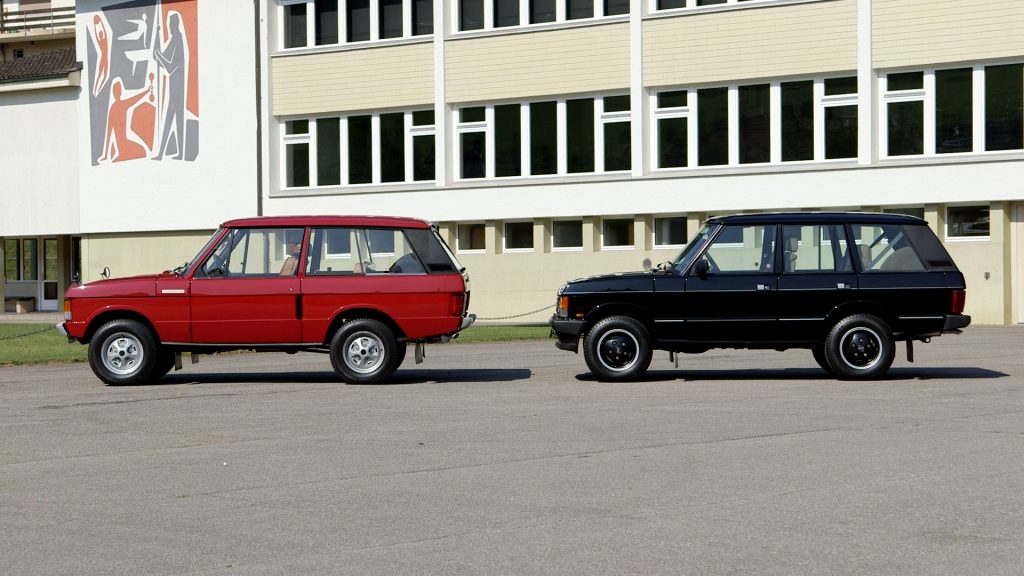
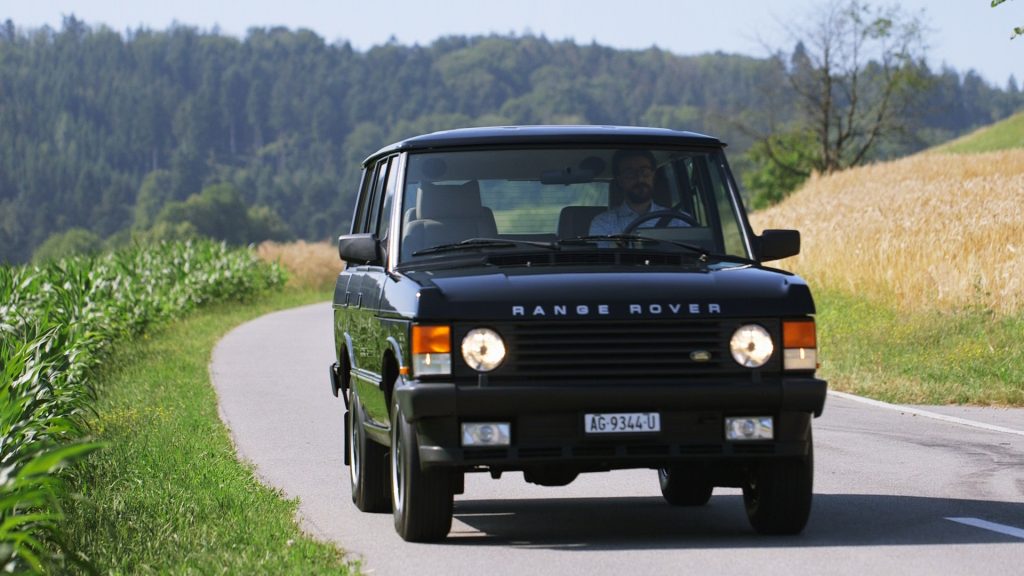
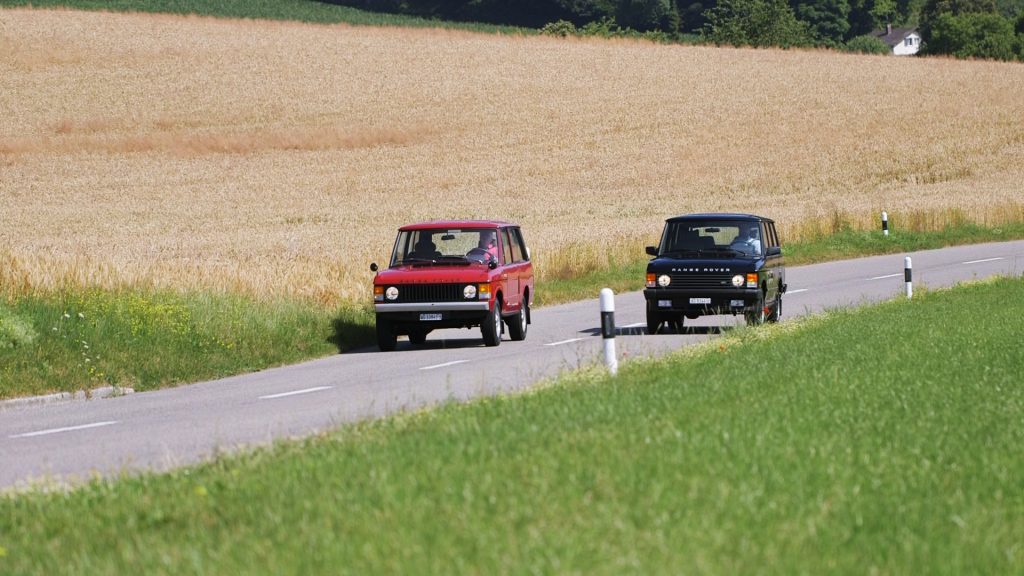
Guest author: Bruno von Rotz
Picture and video: Michael Klauser
Jaguar XJ 12 L – For those who want more

1973 Jaguar XJ 12 L Series II – The Jaguar emblem as a sign of its manufacturing heritage © Copyright / Photographer: Bruno von Rotz
It took around four years for the Jaguar engineers to develop the successors to the 240/340 and 420G series. Drivers were looking for a more spacious and, above all, comfortable high-end saloon. At 4.8 m long, almost 1.8 m wide and weighing at least 1.6 tonnes, the solution came in autumn 1968 with the launch of the XJ 6, which offered unexpected luxury and style. Technically speaking, the engineers relied on both proven and modern elements. The 4.2-litre six-cylinder engine came from its predecessor, though this time offering 186 hp. Whether manual or with Borg Warner automatic transmission, it had power. In addition, the wheels were individually installed and of course equipped with disc brakes.
More luxury thanks to 12 cylinders
In 1972, the long-awaited 12-cylinder engine was made available in the XJ, which then became the XJ 12 and the Daimler Double Six. The 5.3-litre engine, equipped with four horizontal Zenith 175 DD 2 SE carburettors, explained the significant petrol consumption and 253 DIN hp. Automobil Revue magazine reported a consumption of 25.6 litres of super petrol per 100 km and even 36.3 litres per 100 km at a speed of 200 km/h. The 109-litre petrol tank did not seem so generous anymore.
The Jaguar, however, showed the temperament of a sports car, accelerating to 100 km/h in 8.seconds and reaching a maximum speed of 227.5 km/h, despite the Wandler automatic transmission. Already tested on the middle engine of the XJ 13 prototype in the mid-1960s, the engine convinced with its astonishingly quiet performance. As Automobil Revue noted: “At a very slow pace or at idle speed, one cannot stop wondering, by shortly pressing the accelerator and keeping an eye on the revolution counter, if the engine is really on, as it does not make any noise. The vehicle reacts to the slightest touch on the accelerator and goes seamlessly above the 6,500-rpm red zone.”
In the context of the oil crisis, the early 1970s were not the best time for a 12-cylinder guzzling engine. That’s why only 5% of the Series I vehicles sold were equipped with the V12 engine, despite the moderate price surcharge compared with the smaller version, i.e. GBP 4,702.31 against GBP 4,154.15 (longer models).
It took around four years for the Jaguar engineers to develop the successors to the 240/340 and 420G series. Drivers were looking for a more spacious and, above all, comfortable high-end saloon. At 4.8 m long, almost 1.8 m wide and weighing at least 1.6 tonnes, the solution came in autumn 1968 with the launch of the XJ 6, which offered unexpected luxury and style.
Technically speaking, the engineers relied on both proven and modern elements. The 4.2-litre six-cylinder engine came from its predecessor, though this time offering 186 hp. Whether manual or with Borg Warner automatic transmission, it had power. In addition, the wheels were individually installed and of course equipped with disc brakes.
Modernised Series II
Five years after its premiere, Jaguar dealers introduced the redesigned XJ series at the IAA in Frankfurt. The bumpers were lifted to meet US standards. The engineers also took the opportunity to modify the dashboard design and equip the vehicle with a modern ventilation and air conditioning system. The six and 12-cylinder engines were still available. In addition to the four-door version, a two-door coupé was introduced, which cost 10% more and was also used in racing. The 12-cylinder Series II engine saw a slight increase in sales, thanks in particular to the fuel injection system, which increased power while reducing consumption. Of the 97,227 XJ Series II models produced, 14,226 were equipped with 12-cylinder engines.
Series III: A little help from an Italian designer
With the Jaguar XJ 12 PF, Pininfarina had already put forward his own interpretation of an elegant Jaguar saloon. However, that model looked more like a Pininfarina than a Jaguar. The Italian designer was nonetheless called upon again for the redesign the XJ series.
Pininfarina held back and only modified the bumpers, rear lights and roof area to retain most of the model’s classical line for the Series III launch in 1979. The interior boasted a new steering wheel, better seating with lumbar support and more headroom in back. The 4.2-litre engine, like the US version, was then equipped with a fuel injection system for more power. “Generally speaking, the third XJ generation fully meets the current requirements of an upper-class vehicle,” wrote Automobil Revue. This Series III would indeed live quite a long life. Up until 1992, 10,500 of the 132,952 saloons built (including the Daimler versions) were equipped with 12 cylinders. The Swiss racing driver-turned-engineer, Michael May, also contributed to its success.
Swiss efficiency
Elegant looks
Taking costs into account
The 12-cylinder vehicle was redesigned in 1981, a rare occurrence as only Ferrari and Lamborghini continued to manufacture such complex engines in the 1980s. With the help of Swiss racing driver-turned-engineer Michael May, the engine was given a new cylinder head, increasing the power to 295 DIN hp. Thanks to its significant value in terms of consumption, it was soon nicknamed “HE” for “High Efficiency”.
With many other improvements and fine-tuning, both the Jaguar and its sister model, the Daimler Double Six, were manufactured until 1992 – over 300,000 XJ in total.
More than 45 years after its premiere, the shape of the Jaguar XJ 12 remains attractive and subtly elegant. The Series II models have an especially modern and contemporary appearance.
Similar to a gentlemen’s club, the interior welcomes you with wood and leather, and allows freedom of movement. The long version is also very spacious in back, although you would rather sit in the driver’s seat and gently lay your hands on the elegant steering wheel. The engine starts as soon as the key is turned, producing a soft baritone sound at idle speed. No sooner is the automatic transmission engaged than the saloon starts moving. The car enables effortless driving and steering. With a light touch on the pedal, the vehicle accelerates immediately. It is easy to understand why the test pilots spoke of a sports car’s temperament. This “feline” accelerates to 100 km/h twice as fast as an Opel or Ford from that time.
Nowadays, one naturally does not drive such a car as intensely as 40 years ago. And the high petrol costs quickly become an issue. The maintenance costs for the 12 cylinders, 24 valves and 9.1-litre oil capacity also take their toll.
If interested in a Jaguar XJ 12, it is important to understand that the maintenance and service costs are not cheap. Yet when well-maintained and cared for, the 12-cylinder Jaguar saloon still provides style in motion and a comfort that not many other vehicles can match.
Guest author: Werner Bartholai
Pictures: Bruno von Rotz – Balz Schreier – Archiv Zwischengas
Bentley Continental R – The new self-confidence of an iconic brand
In 2019, Bentley could look back on a 100-year history that included several Le Mans victories and many iconic models. The manufacturer of the famous Bentley Blower had lost much of its independence back in 1931, when it was taken over by Rolls-Royce. By the start of the 1980s, only five percent of all cars produced by Rolls-Royce/Bentley carried the Bentley branding – and the car make was almost forgotten.
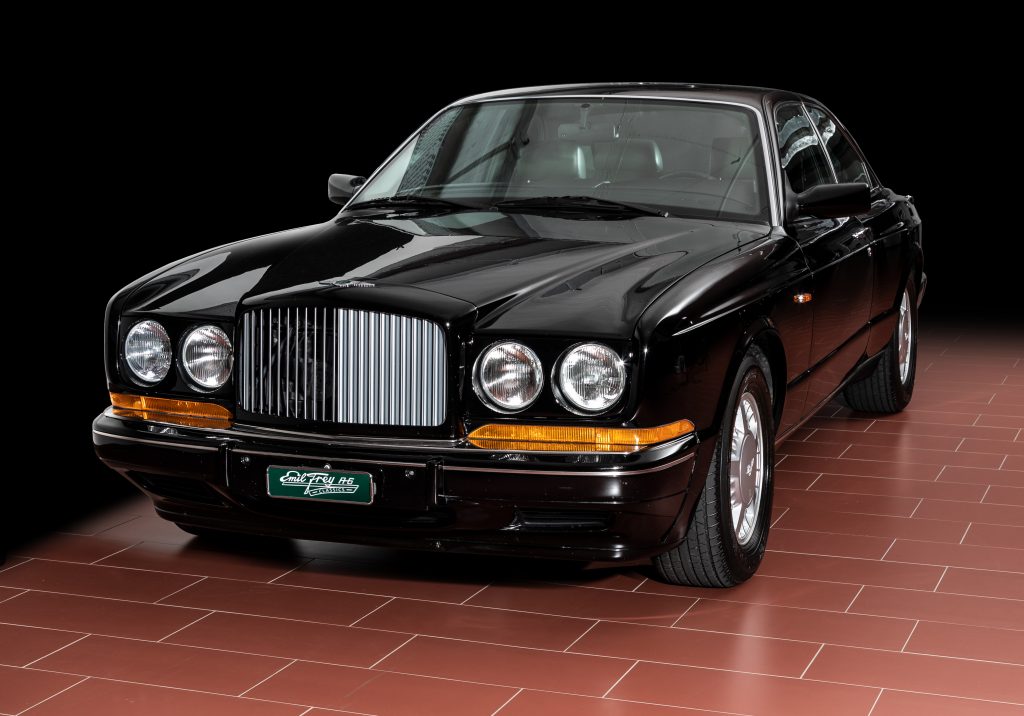
The legend that came before
From a somewhat to a world premiere
Much acclaim
At the Geneva Motor Show in March 1985, the Bentley stand featured the “Project 90” – one of the concept cars by John Heffernan and Ken Greenley – which measured in at 534 cm long and 190 cm wide. While the car’s looks did not exactly win people over, it did spark interest in the prospect of a stand-alone model from Bentley.
At the Geneva Motor Show six years later, the prototype of the Bentley Continental R took everyone by surprise. Its premiere was anticipated in 1992, one year later, but distribution problems – especially in the US – forced the carmaker to move up the launch. As a side note, the Mercedes Benz S-Class (W140) was also launched at the 1991 show, only to be overshadowed by the unexpected new Bentley.
More than 45 years after its premiere, the shape of the Jaguar XJ 12 remains attractive and subtly elegant. The Series II models have an especially modern and contemporary appearance.
Similar to a gentlemen’s club, the interior welcomes you with wood and leather, and allows freedom of movement. The long version is also very spacious in back, although you would rather sit in the driver’s seat and gently lay your hands on the elegant steering wheel. The engine starts as soon as the key is turned, producing a soft baritone sound at idle speed. No sooner is the automatic transmission engaged than the saloon starts moving. The car enables effortless driving and steering. With a light touch on the pedal, the vehicle accelerates immediately. It is easy to understand why the test pilots spoke of a sports car’s temperament. This “feline” accelerates to 100 km/h twice as fast as an Opel or Ford from that time.
The new concept car by John Heffernan and Ken Greenley, who had also designed the Aston Martin Virage, impressed the critics. Despite its enormous dimensions (534.2 cm long, 187 cm wide and 146.2 cm high), the car proved to be more elegant and less bulky than its size would suggest.
Even its drag coefficient (cD value) of 0.385 was considered state-of-the-art. But the Continental R, whose name recalled the Continental model of the 1950s, did not include the expected four-valve Bentley engine.
Heavy weight
A sports car with luxury in its genes
After the premiere, it took about a year before the first Continental R models were delivered. Nearly none of the specifications had changed. To make the driving performance of the nearly 2.4-ton coupé more competitive, the Turbo R engine received a 10% boost. The result was 320 hp for a powerful drive and, at least according to the factory, 0 to 60 mph (96 km/h) in 6.6 seconds.
Priced at 462,387 Deutschmarks or 376,850 Swiss francs, the coupé was clearly aimed at the super-rich, who would be getting a stylish cockpit and proven Bentley technology. For the first time, the gears of the four-speed automatic (from GM) could be shifted with a lever on the middle console. The Bentley had its share of clever electronic gadgets as well.
The chassis featured independent double wishbone front suspension and independent multi-link rear suspension with hydropneumatic spring struts. Electronically controlled, the coupé aimed to strike a balance between sportiness and comfort.
While the 6.75-L light alloy V8 engine with central camshaft dated back to the 1960s, the addition of Garrett turbochargers and Bosch KE Motronic injection brought the performance and environmental friendliness up to the present.
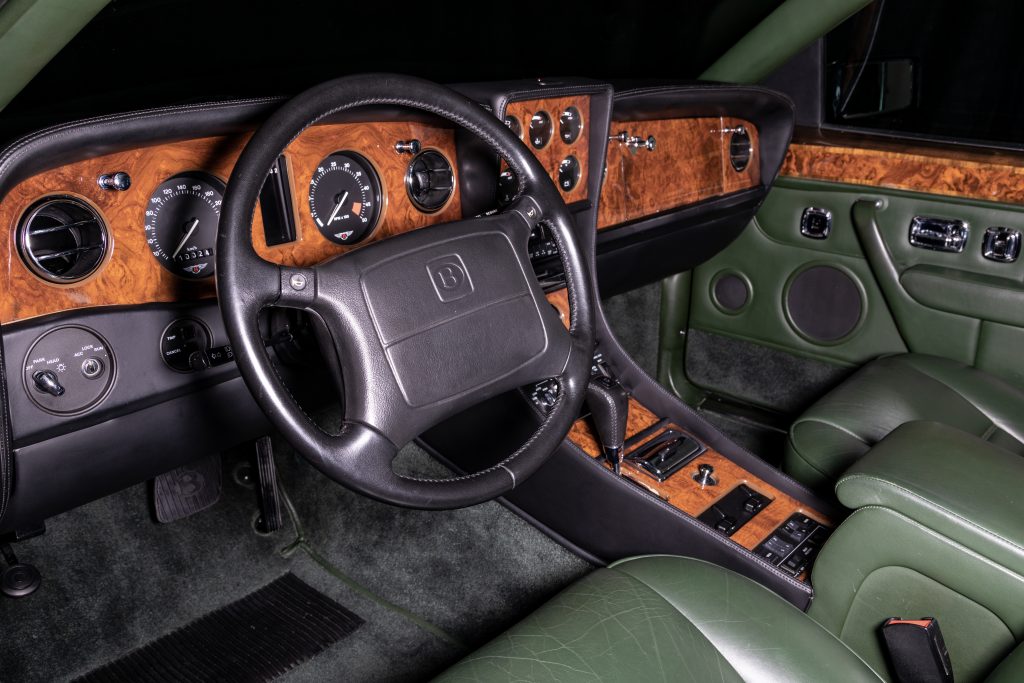
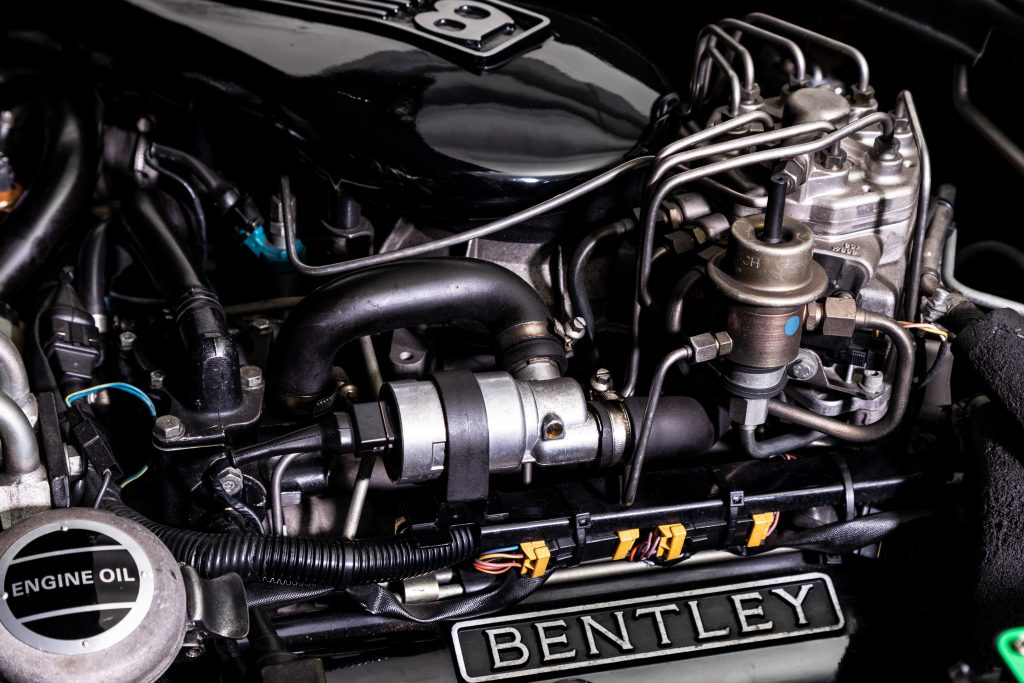
Needless to say, car magazines jumped at the chance to test-drive the speedy Bentley coupé. It did not, however, live up to its promises. In June 1992, Automobil Revue clocked 8.3 seconds for 0 to 100 km/h, with the maximum speed reported “over 240 km/h”. The fuel consumption levelled off at 16.8 litres per 100 km based on the test runs – not bad for a fully loaded 2.8-ton coupé.
The magazine classified the car as a “tourer for long trips” but criticised the stiffening of the suspension on German motorways. In general, the compromise between sportiness and comfort did not completely succeed, and it would have been nice to be able to fiddle with the electronics.
As for the roominess and interior, there was little to complain about. Automobil Revue concluded: “With the new Continental R, the Bentley brand reclaims a good part of the independence it lost over the past three decades. The new luxury coupé marks a new beginning – one which is full of promise yet also raises expectations!”
Wolfgang König from Auto Motor und Sport also got behind the wheel of the Bentley coupé, which slightly exceeded the length of the saloon. He, too, was critical of the driving comfort when the suspension switched to the sporty setting. But overall, his review was positive: “In the normal setting, the Bentley is tight enough, even comfortable enough, and, like the saloon, surprises with its unexpected ease of handling. The cardinal question, however, remains: Can such a car really be worth 460,000 marks? For Continental drivers – more than 500 are rumoured to have already placed their order – this is not an issue and the question does not even come up.”
Several years after, in 1996, Motor Revue compared the Continental R with the Mercedes-Benz 600 SEC. Although the Mercedes was not even half the price and featured a lot of wood and leather in its stylish interior, it still fared poorly against the Bentley. The Mercedes-Benz was more modern from a technical standpoint, yet in some respects could not keep up with the Bentley, especially in terms of style.
Reviewer Götz Leyrer wrote: “The icing on the cake is the view over the bonnet. With the Mercedes, the view is the same as with all other cars: almost nonexistent. The Bentley, on the other hand, has a tapered bonnet just like in the old days, infinitely long, a symbol of the power that lies beneath it.” In summary, he put it like this: “Driving a Bentley is a matter of conviction. You have to be forgiving of certain weaknesses and can’t expect absolute perfection, and you also have every right to be annoyed by the fact it has one of those dreadful steering wheels with an airbag hidden in the hub. If you want the perfect car, buy a Mercedes. And remove the intrusive lettering. That is the first step on the path that may well lead you to Bentley.”
Ever faster
Successful rarity
Gliding in comfort
In 1996, Bentley launched the Continental T with a slightly shortened wheelbase and 400 hp, and eventually 426 hp, for increased performance. At 500,000 Deutschmarks or 421,200 Swiss francs, the Continental T was even more expensive, but it now went from 0 to 100 km/h in 6.6 seconds and did so without a significant bump in fuel spending compared to the R.
A total of 1,854 Bentley Continental R, S and T models were built between 1991 and 2003, with the R, including several limited-edition models, making up the majority. Only 350 of the Continental T were produced, along with 79 of the Continental SC, a Sedanca coupé variant.
The Bentley Continental R has long been considered a classic, even if it did not actually originate in the classic car era. Surrounded by pleasing leather and beautifully finished Californian wood, the driver can get comfortable in no time and leave everyday worries behind. The engine is started by turning the key in the ignition, left of the steering wheel, and the desired gear is selected by lifting the gearshift of the four-speed automatic gearbox.
The Bentley Continental R is a first-class glider, and nobody would think of taking it out for a joyride on a curvy road. For this reason, there is really no need to opt for the S (sport) gear, which only makes the ride less smooth. If the driver takes it easy, the suspension feels comfortable. The overall visibility is excellent and makes the car seem more compact than it is. The power steering also plays an important role in that respect. The Bentley Continental R would be an ideal companion for a long road trip, which is ultimately why it was designed.
Guest author: Bruno von Rotz
Pictures and Video: Michael Klauser
Aston Martin V8 Vantage V600 Le Mans – Driving with thunder
To sell half a million super sports cars at the end of last century, you must have had something worth buying. Aston Martin played on the memory of its 1959 success at Le Mans and introduced the Aston Martin V8 Vantage V600 Le Mans, a highly refined, limited special edition.
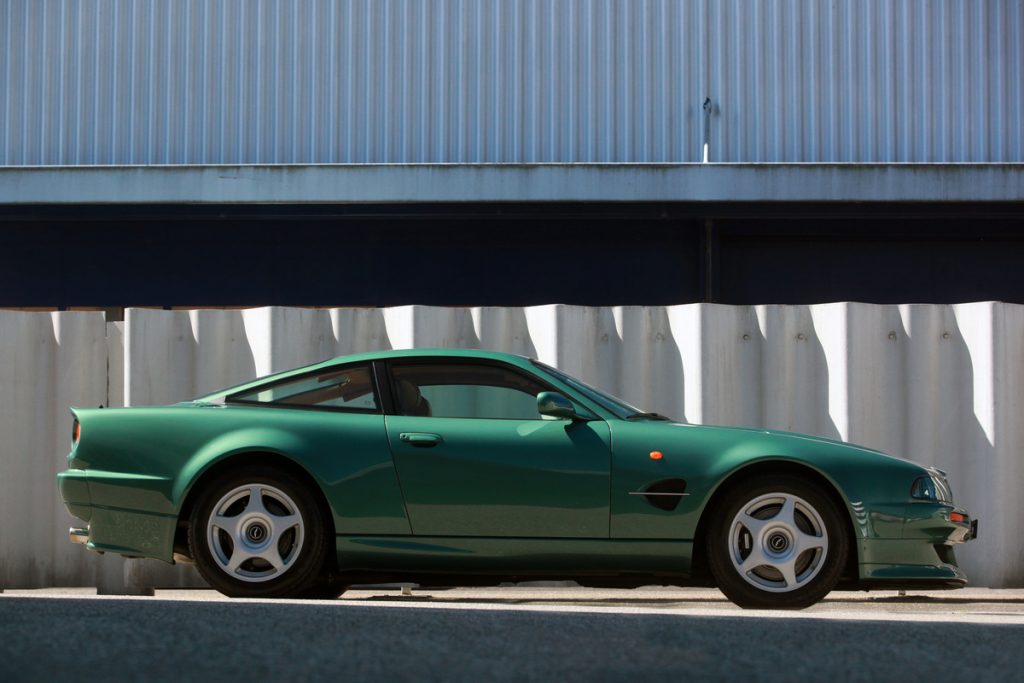
Aston Martin V8 Vantage V600 Le Mans (2000) – 474,5 cm long
The end of a longstanding tradition
The history of Aston Martin traces back to 1913. David Brown began running the company in 1947; and in 1959, Carroll Shelby and Roy Salvadori, followed by Maurice Trintignant and Paul Frère, achieved a one-two victory at Le Mans, beating the best Ferrari by 25 seconds.
In 1967 the Aston Martin DBS, designed by William Towns, replaced the DB6. From 1969 onwards, the new light alloy V8 engine, designed by Tadek Marek, gave it additional propulsion.
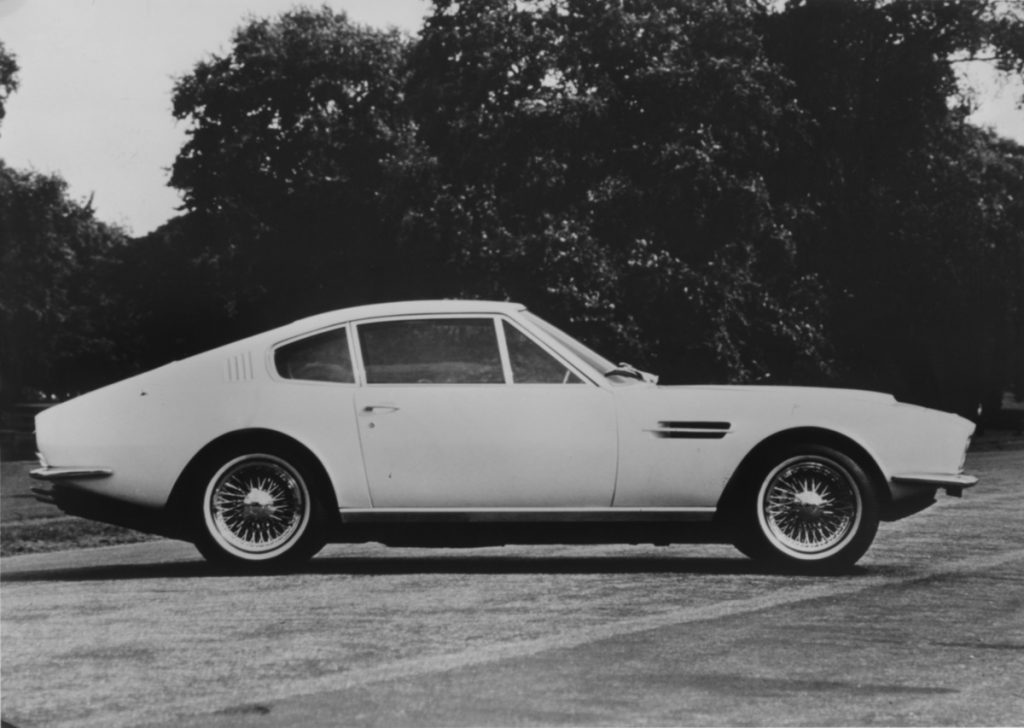
Aston Martin DBS (1967) – with six-cylinder engine (© Archiv Automobil Revue)
From the V8 to the Virage to the Vantage
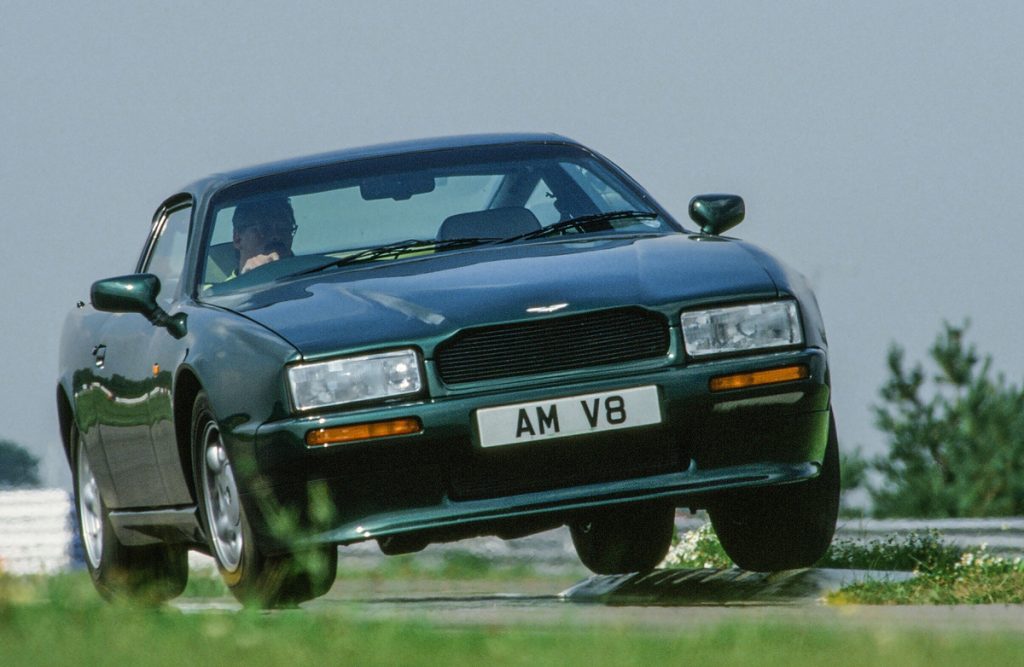
Aston Martin Virage (1990) – dynamic test drive in Silverstone (©photographer: Daniel Reinhard, 1990)
The V8 was built (in part as a Vantage variant) until 1988, when it was replaced by the Virage. While this model had a more angular design, the improved technology of the predecessor could largely be found beneath the exterior. Even the De Dion rear axle survived the model change and was produced for another decade.
In 1992 the Virage was joined by the Vantage, which differed both visually and technically. The front and rear had undergone extensive restyling, and the V8 5.3-L engine, now with two Eaton compressors, boasted 558 hp.
No half-portion
The Aston Martin Vantage weighed in at a hefty 2015 kg when it was tested by Auto Motor und Sport magazine in 1997. But the 745 Nm (at 4000 rpm) and 557 hp (at 6500 rpm) ensured enough propulsion. The Vantage could hit 0 to 100 km/h in 5.2 seconds, reaching a top speed of 281 km/h. Although the Aston was not exactly economical, consuming 19.1 L of Super per 100 km, it could not be considered a gas guzzler, either.
No clear test winner
Despite its performance advantages, the Aston could barely measure up to the competition out of Detroit or Maranello – at least objectively speaking. The Ferrari F550 Maranello could accelerate more quickly, reach a higher top speed by 36 km/h and weave through a slalom course 20 km/h faster. In a comparison test against the Chevrolet Corvette, Dodge Viper and Ferrari F550, the Aston came in last. Only in the body category could it catch up to the Ferrari.
But such rankings probably had little effect on typical Vantage buyers, including Tom Cruise and Prince Charles, who would have never opted for a Corvette over the elegant Aston Martin. The Vantage interior, made from at least 11 cowhides of Scandinavian origin, brimmed with classic British style. Everything was handmade by masters in their field, and not in a matter of hours but weeks. Even the large series parts from Ford and GM did not tarnish its image. If you were a gentleman who could afford it, you simply drove an Aston, not a Corvette.
The boys at Aston Martin in Newport Pagnell, England, ended up retrofitting the Vantage, even if lagging performance was hardly the reason the Aston Martin could not match the Ferrari 550 Maranello.
V550 and V600
From 1998 onwards, Aston Martin customers could bring their Vantage back to the factory and order a V600 performance “cure”. The cure, at a cost of around £20,000, upped the horsepower to 608 hp at 6200 rpm and the torque to a whopping 813 Nm.
It also significantly cut down the sprint from 0 to 100 km/h to under five seconds. From then on, the “normal” models were sold as the V550.
The future calls
In the meantime, the world kept turning. New emissions and crash regulations hastened the end of the Virage, at that time called the V8, as well as the Vantage. The DB7, one car class lower, went on to enjoy success in the mid-1990s, with the Vanquish already on the horizon. But Aston Martin knew their fans and wanted to close out the Tadek Marek V8 series with one more highlight.
In March 1999, the Aston Martin V8 Vantage V600 Le Mans premiered at the Geneva Motor Show as a limited special edition. The plan was to build 40 of these special models to mark the 40 years since the DBR1 had won at Le Mans, in 1959.
Brute force
The limited edition went far beyond a few catchy stickers and labels. It featured a unique grille, which contained two bold ventilation openings for the Eaton compressors. The front spoiler was adapted, as were the tailpipes of the exhaust system.
The cockpit harkened back to the DBR1, with its large rev counter and small speedometer. All the wood had gone, and a titanium finish was used instead.
The customer who was willing to invest over CHF 500,000 (£225,000) in this car could choose the V600 option. Most probably did. The buyer – whose name, along with the vehicle number, was printed on a plaque inside the car – was also treated to a reinforced braking system with four-channel ABS and a tighter suspension. The model also featured 285/45 ZR 18 tires, mounted on magnesium rims with hollow spokes, as well as parking sensors.
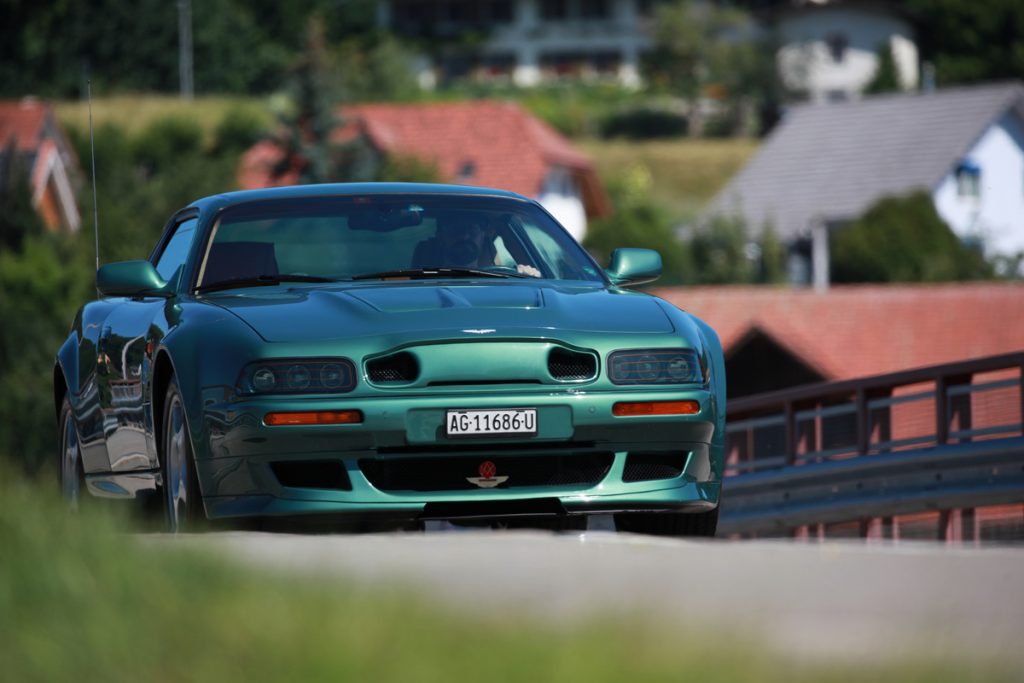
Aston Martin V8 Vantage V600 Le Mans (2000) – requires a lot of space and exercise (©photographer: Bruno von Rotz, 2020)
For the speedy gentleman
With these specifications, the Aston Martin V8 Vantage V600 Le Mans could, according to the carmaker, reach a speed of 320 km/h and clear 0 to 100 km/h in 3.9 seconds. It is safe to say, however, that few owners ever enjoyed this level of performance. From the start, the cars were collector vehicles and likely sat in heated, moisture-controlled garages. And if the car did happen to show up on the open road, it would have attracted attention more for its impressive exhaust rumble than its exterior – especially with most models painted in unobtrusive shades of green, grey or black (13 coats!).
If you did get to sit behind the steering wheel (taken from the Lincoln Continental) of one of these rare cars, you could enjoy the endless torque and propulsion to no end. And you could also be annoyed by the relatively stubborn six-speed gearbox and unforgiving clutch. In effect, the Aston was not built for stop-and-go, 30 km/h speed zones or narrow pass roads because of its 194-cm width. The car – at 475 cm long and weighing in at two tons – feels most comfortable on wide, slightly curvy country roads or on the motorway. The only real difference between driving in third or sixth gear is pitch, as there is always enough power.
And speaking of pitch: even if a Ferrari F550 runs quietly in comparison, the sound is not so disturbing and in fact rather harmonic. In any case, the car’s sonic expressiveness should not warrant any Sunday driving bans. After all, the probability of seeing an Aston Martin V8 Vantage V600 Le Mans drive past remains, in the end, very low.
Guest author: Bruno von Rotz, Zwischengas
Video: Michael Klauser







